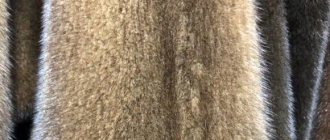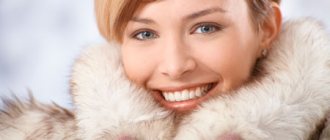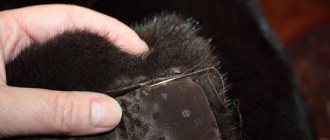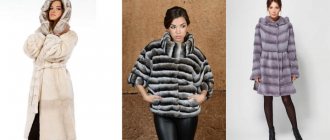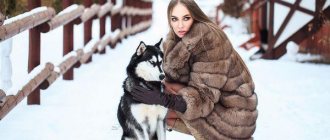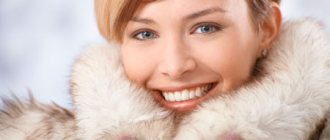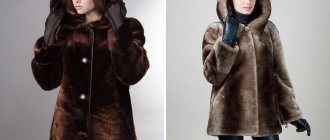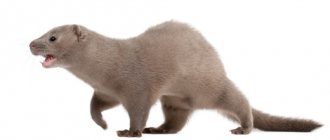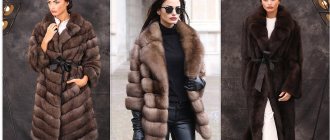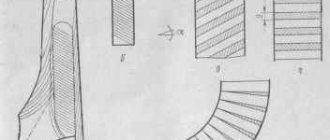Mink coats made from Canadian mink are the splendor and beauty of the material. The main feature of this fur is its beautiful black color, which in daylight shimmers slightly with a brown tint. The second quality that the Canadian mink has is its short spine combined with thick underfur. All together helps create a velvety effect that will certainly attract the admiring glances of others.
What does a Canadian mink look like?
It has high-quality fur of excellent dressing and is characterized, firstly, by a deep and bright black color with a light brown tint, which is not immediately visible. Experts call this the color of oil.
The second feature of the Canadian mink is its short awn, which in combination with the fluffy thick underfur creates the feeling of velvety fur. It is important to note that it is not too shiny in the light, but rather has a matte finish. It is also worth noting that black Canadian mink is not fluffy due to the short guard hair, but at the same time it is not smooth due to the elastic, dense down; this makes things made from it especially beautiful and eye-catching.
Where to buy a quality fur coat in Moscow
Customers are actively advised not to focus their attention only on online stores, but to look into the boutiques of their city. The most popular boutiques are Tatyana Dorozhkina, Annabella Beauty, and the Mala Mati salon.
If one doesn’t care about the price, the main thing is the quality of the product, then the other might want to save a little money. So you should choose a store to buy, taking into account the amount you are willing to spend for your happiness.
[Show slideshow]
Types of mink: how to distinguish Canadian
Today, there are several types of mink fur on the world market. The main ones are European, Scandinavian, American and Canadian. In order not to get confused in terms in the store and know exactly what to choose, it will be useful to learn about the differences between this fur. This will also help if you end up with an unscrupulous seller. Black mink is at the peak of popularity today and is not cheap, it is not surprising that any black mink coat is often passed off as it.
European mink is not very common today. The fur has a brown tint and is characterized by high guard hairs and thick underfur.
Another option is Scandinavian mink. It is the most common in the world - about 80% of all fur products are made from it and it is much cheaper than Canadian fur. It is distinguished by a more shiny pile than that of Canadians, for which this fur is nicknamed “black diamond”. In nature, the Scandinavian mink has a deep brown color, but for the sake of fashion, its fur is tinted black and is often passed off as Canadian.
The closest relative is the American mink. The fur of these breeds is naturally blacker, like that of Canadians. In fact, American and Canadian minks are the same breeds, with approximately the same high quality fur. American skins are sold at auctions in Seattle, and Canadian skins are sold in Toronto. The best American fur is from the Black Glama brand, and the Canadian Black Nafa.
Social structure and reproduction
Photo: Minks in nature
The mating season for minks usually lasts from February to April. At this time the animals are very active. Several males can chase one female at once. They compete with each other and squeal funny. Sometimes there are fierce battles for the lady of the heart. When the female is fertilized, the male leaves her. Adults live separately after mating.
The entire pregnancy of a female animal lasts relatively short - about forty days. Offspring are usually born by May. At one time, the female reproduces no more than seven babies. By mid-summer, small animals reach almost half the size of an adult. In August they grow to their final size. At the same time, the female stops feeding her cubs with milk. They learn to get food on their own, their diet becomes entirely meat-based. By autumn, the offspring leaves the mother's burrow.
Interesting fact: Minks reach sexual maturity at ten months. Until the age of three, these animals have the highest level of fertility. Over time, the fertility of females gradually decreases.
The total lifespan of small predators is no more than ten years. However, in captivity, minks can live much longer - more than fifteen years. They quickly adapt to home conditions, but even after many years they do not become completely tame.
How to recognize a fake
Black Canadian mink accounts for only 5-7% of the world market for this type of fur. This fact, as well as the highest quality of fur, makes it quite expensive and exclusive. Naturally, both completely different fur and fakes of frankly poor quality are often passed off as Canadian mink.
The first thing you need to know is that if the label of a fur coat says “Black Nafa,” this means that the product must have the appropriate certificates and a number assigned by the auction in Toronto. On the website of this auction house you can easily verify the authenticity of the number.
Often the fur of a different breed of mink, or even another animal, is passed off as a Canadian mink. Often they try to pass off a marmot as Black Nafa. From a distance, it really looks like the more elite fur of a Canadian mink, but what gives it away is that the guard hairs of the marmot are of different lengths, unlike mink. Upon closer inspection, the fur does not look evenly velvety, but is too disheveled.
It is also rare to see honorik fur passed off as mink. This animal is the result of crossing a ferret and a mink and its fur shows different shades of down and guard hairs. However, much more often tarbagan fur is passed off as mink. This is a steppe wild mink, common in the steppes of Mongolia. Tarbagan is used to make Chinese fur coats that are successfully passed off as Canadian. A comparison of the stiffness of the fur (it is higher in a steppe animal) and the flesh (in a tarbagan it is much less elastic) will help you distinguish a fake.
Features of character and lifestyle
Photo: Mink animal
Minks live mainly in forest areas, near water sources: rivers, reservoirs, lakes. They prefer to live, breed and hunt in relatively small and cluttered areas. They practically do not appear in cleared areas, beaches and open areas. They love to build their nests in reed thickets and bushes.
The animal creates holes on its own or uses existing holes in the ground: natural depressions, small cracks, abandoned rat holes or hollows. The animal constantly uses its home. He can leave it only in two cases: flood, lack of food in the winter.
The burrows are usually small, but divided into several zones. There is a main sleeping area, a restroom and several exits. One exit necessarily leads to a water source, the second – into the thickets. The burrows are lined with available natural materials: feathers, moss, leaves, dry grass.
Fun Fact: According to an ethological study done in the 60s, minks have the highest visual learning skills. In this skill, they surpassed cats, skunks and ferrets.
This animal's peak activity occurs at night. However, if the night hunt was unsuccessful, the mink may be active during the day. The animal spends most of its time on land and searches for food. In winter, these animals are forced to walk more, because it becomes more difficult to find suitable food. The animal also devotes a lot of time to swimming. It is excellent at traveling long distances through water, diving, and deftly catching fish and amphibians.
The nature of wild predators is unfriendly, but not aggressive. Minks prefer a solitary lifestyle and rarely come close to humans. It is very difficult to see such an animal in captivity. Its presence can only be indicated by characteristic footprints on the soil.
How to choose a quality fur coat
The main test for the authenticity and quality of the fur will be an attempt to get to the core, that is, to the skin of the skin. Since the Canadian mink has a very thick and dense undercoat, it is not so easy to move it apart. The flesh should be light - beige or grayish. Black skin indicates that the fur was dyed, which means that Black Nafa is passed off as another mink, often a cheaper Scandinavian mink, dyed brown to black. At the same time, it is allowed to tint Canadian fur in a deeper black color in order to equalize the shades of different skins for one product. In tinted fur, the underbelly will still remain light, and you can check the quality of the color with a white scarf lightly moistened with water. When you pass it over the fur and skin, there will be no streaks left on the scarf.
In addition to color, the skin should be smooth and elastic. Dry and rustling fur indicates that the fur will begin to fall out within a couple of seasons. But a black mink coat made from high-quality skins can last up to 10 seasons without losing its appearance.
By the way, the lining of a Black Nafa mink coat is necessarily made of natural silk.
Basic rules for purchasing high quality fur products
When planning to purchase a fur coat made of natural fur, you should go to a store that has proven itself well and provides the appropriate certificates and guarantees. In pursuit of savings, you should not look for options in the market. You can find fakes there most often, but then it will be difficult to find the ends.
Now we’ll tell you how to distinguish a high-quality mink coat.
- Mink fur is elastic. Run your hand along the pile in the opposite direction. It should return to its original position. Despite its elasticity and rigidity, the fur does not prick.
- Smooth undercoat, awns of the same length. To disguise a fake, sellers often cut the guard hair so that the length is the same. But in this case, the fur will prick.
- There should be no hair left on the hand when pinched.
- Mink skin has a shine. Single white hairs are sometimes visible on undyed pile.
- Run a white cloth over the fur. There should be no traces of paint left on it.
Canadian mink coats
The climate of Canada is very similar to Russia, so there is no doubt that a Canadian mink coat will be especially warm. This fur warms well thanks to its dense underfur, so a fur coat from Black Nafa Mink is not only beautiful, but also comfortable.
Short mink coats are very popular, as they are comfortable to drive in, and they also have a more affordable price than long coats. Knee-length fur coats are also popular; they are warm and very beautiful.
As for the styles, black mink is beautiful in any product - in a fitted silhouette or in a batman style, with a hood or an English collar, with a stand-up or cowl collar, with full sleeves or shortened ¾ and ⅞ lengths. Canadian mink coats are often complemented with trim from other equally luxurious fur. This could be a collar, sleeve trim or patch pockets made of long-pile fur, such as sable or lynx.
Black mink also looks good in jackets - shortened fur items with a stand-up collar and ¾ sleeves. This mink jacket will perfectly complement any evening outfit.
Fashionable this season, long vests are made not only from coat fabric, but also from fur. So, a black mink vest would be appropriate in cool autumn or spring.
What does a mink eat?
Photo: Black mink
A mink's daily diet may consist of:
- Mouse-like rodents: water rats, field mice;
- Fish. The animals will not refuse perches, minnows, and brown trout. In general, they can eat almost any fish;
- Marine animals: crayfish, mollusks, various marine insects;
- Amphibians: tadpoles, small toads, frogs, eggs.
Animals living close to populated areas often visit people for treats. They sneak into barns, chicken coops and deftly catch poultry. If an animal is very hungry, then it may not be shy about human food waste. However, most members of the family still prefer to eat fresh food. If there is no such thing, then they can even starve, but no more than four days.
Minks can often be seen in trees. There they can feast on bird eggs. The average mink eats about two hundred grams of food per day, preferably fresh. If during a hunt the animal comes across large prey, then it can leave it for hungry times or for the winter. The prey hides in a special shelter.
Minks are convinced predators. However, if the hunt is unsuccessful, they may for some time eat food that is not entirely typical for them: berries, roots, mushrooms, seeds. If the animal is domesticated, then people feed it with special food (dry and wet) and fish fillets.
Fur care
Having bought such an expensive fur coat made of elite fur, you should take care of caring for it. During the off-season, store your mink coat in a special fabric case impregnated with an anti-moth compound. It is best to store a fur coat in a spacious, cool and dark closet, without squeezing it with other clothes.
During the season, try not to wear bags with a long strap with your fur coat, so as not to damage the fur on your shoulders and thighs, and also tie a silk scarf around your neck so that the fur does not start to shine when it comes into contact with your skin and hair.
If you get caught in snow or rain in your fur coat, do not dry it with electric appliances, but carefully hang it on hangers and let it dry. Do not clean heavy stains yourself, but have them dry cleaned.
Manufacturer country
Depending on the country in which they are produced, mink coats have several types. Canadian and Scandinavian minks are considered one of the most expensive. They are distinguished by abundant fluff and very thick pile of medium length. The Ukrainian mink is slightly inferior to them. Its underfur is not so thick, and its awn is longer.
Greek fur coats are very popular among Russian women. There is also an opinion that the cost of fur coats is lower in Greece. Some even go on special tours to buy furs. But in any country there are both high-level and less conscientious manufacturers. A high-quality mink fur product will not be cheap. Therefore, it is better not to take risks by making expensive purchases in resort areas.
Russian and Chinese mink coats are much cheaper. Currently, some Chinese manufacturers have also learned to make good quality fur products. But there are also plenty of fakes among them. Therefore, it would be a shame to buy a Chinese fur coat at the price of a Canadian or Greek one. Here are a few signs by which you can distinguish a Chinese fur coat from a European one:
- Ost. Pronounced and very high. Outwardly it seems prickly. It's like she's lying on the pillow. But sometimes the spine does not differ in height. In this case, the skin can be passed off as Scandinavian.
- Shine. Chinese skins do not have a smooth sheen; they seem to shine in areas. They can be recognized by their characteristic glassy sheen. If you compare Chinese and Scandinavian fur coats, even a non-specialist will immediately notice the difference. Scandinavian furs are distinguished by a beautiful diamond shine that seems to shimmer in the sun.
- Undercoat. Depends on the length of the spine. With a long guard, the undercoat is not dense. Sometimes a mink with short hair and long black fur is passed off as a black mink. But natural black mink has a light core, which after dyeing takes on a dark or gray tint.
Based on these indicators, you can understand where the animal was raised. The place where the fur coat was produced is determined by the sewing technology. In most cases, Greek and Italian fur coats are made from Finnish and Scandinavian skins. Russian mink differs from Chinese mink in having thick and long pile, while Scandinavian mink has thick but short pile.
Sometimes the Chinese use Greek furs for tailoring. In this case, quality should be determined by sewing technology.
How to navigate the price?
How much does a good mink coat cost? The answer to this question depends on many nuances, not all of which are directly related to fur. For example, the price of a lightweight fur coat of a standard style of medium length, unsuitable for a frosty winter, but ideal for temperatures of zero degrees, in the Snow Queen chain of stores is about 60,000 rubles.
The cost of a warm fur coat below the knee length is close to two hundred thousand; mink fur coats are in the same price range. But combined products that combine mink fur with other furs are several times cheaper. A mink and rabbit fur coat will cost 30,000 rubles.
Characteristics of individual categories
A normal factory fur coat has a certificate that specifies the categories of skins used in sewing.
| Category | Material length (in cm) | Material width (in cm) |
| "A" | Above 70 | 7.5 and wider |
| "B" | 65-70 | 7 |
| Large | 54-65 | 6,5 |
| Average | 47-54 | 6 |
| Small | 40-47 | 5 |
| Trim | Less than 40 | Less than 5 |
When sewing a fur coat, skins of different categories are used. But all of them are stated in the certificate attached to the product.
Features of mink fur
Animal skins are obtained in two ways: by hunting wild mink and by breeding animals in special farms. There are special criteria for assessing the quality of raw materials, depending on the habitat, size and color, number of flaws, length and thickness of the spine.
When assessing the density of the pile, you need to know that mink fur contains about 22,000 fibers per 1 cm2 of fur. Their length is up to 25 mm. The thickest pile is on the animal’s tummy, and on the ridge it is the longest.
Benefits of mink fur:
- high thermal insulation;
- softness;
- pliability;
- shine;
- strength;
- light weight;
- increased practicality;
- resistance to mechanical stress, the influence of various temperatures, moisture, sunlight.
Mink products made from males and females are different. “Men’s” skins are heavier, larger, warm and fluffy, suitable for sewing short outerwear and hats. “Women’s” is an ideal material for making long, flared items, as they are soft, elegant, have less dense fur and are light in weight. They fit perfectly to the figure, giving the silhouette an attractive, slim look.
Distinctive characteristics of products from different countries
Expert advice and recommendations regarding mink products differ depending on the country in which the animals were raised. Scandinavian fur products are considered to be the best.
Scandinavian fur is divided as follows:
- Finnish, with product labeling – Saga Furs.
- Danish, marked as Copenhagen Furs.
Finnish products are distinguished by high guard hairs and abundant undercoat. Danish minks look different. The guard hairs are set low and lie close to the undercoat. Danish skins do not look fluffy.
| Country of origin | Characteristics |

